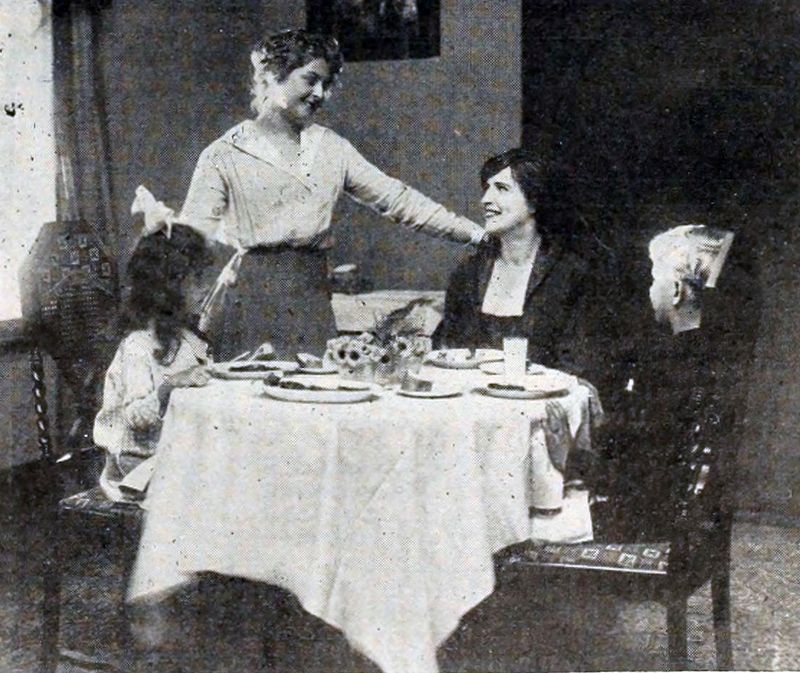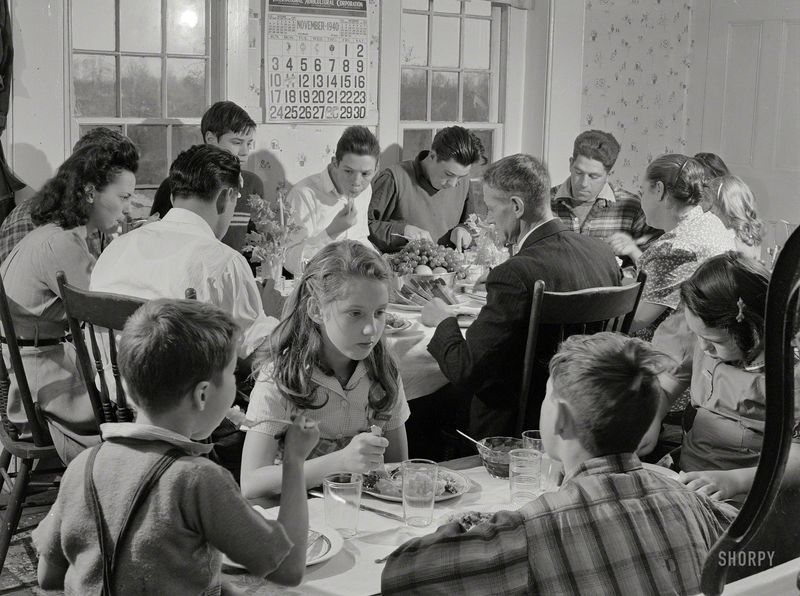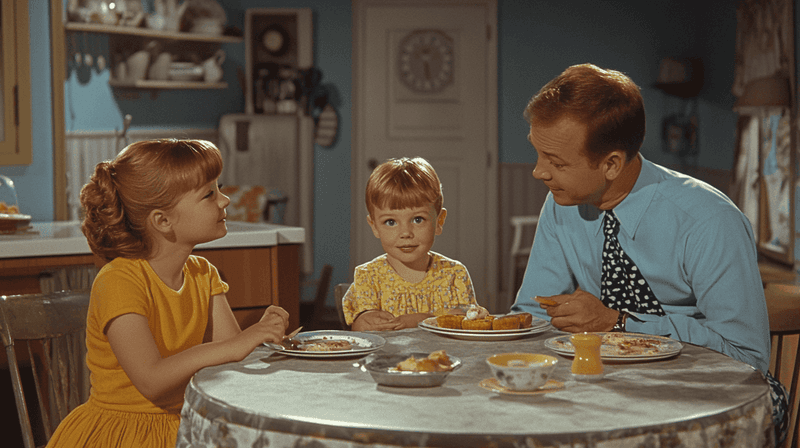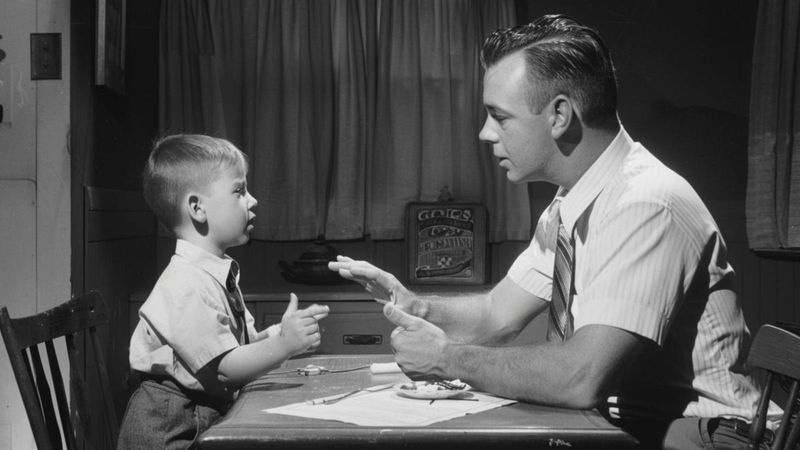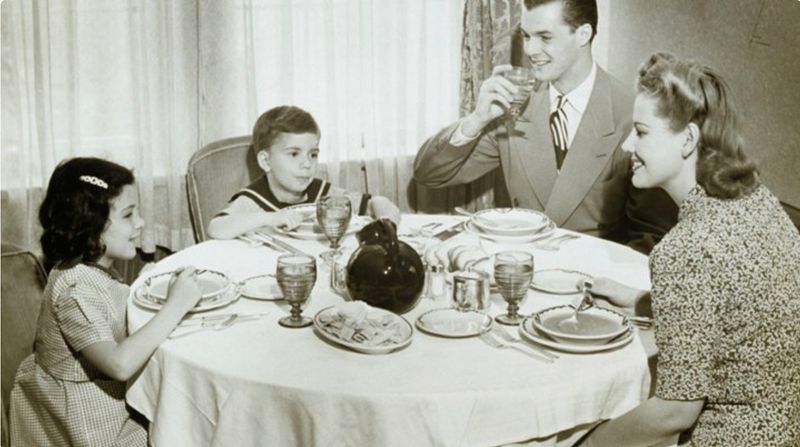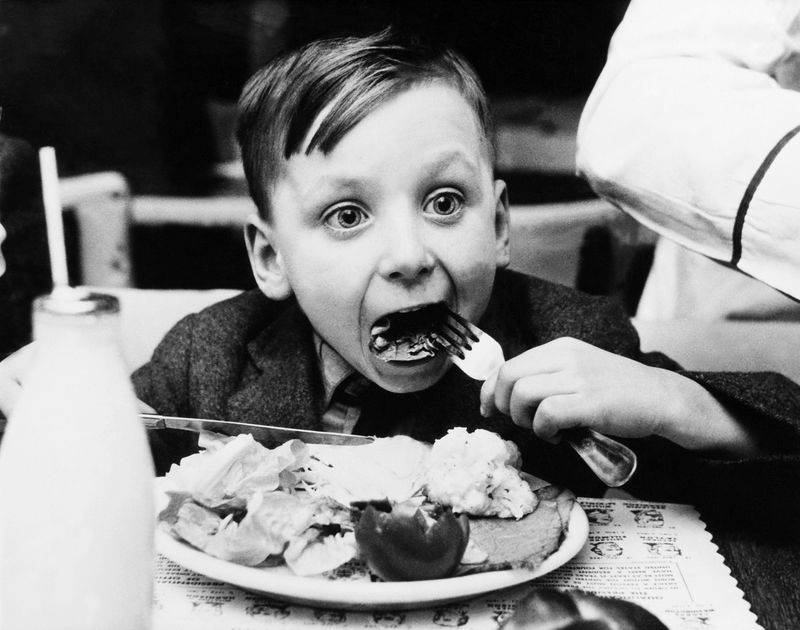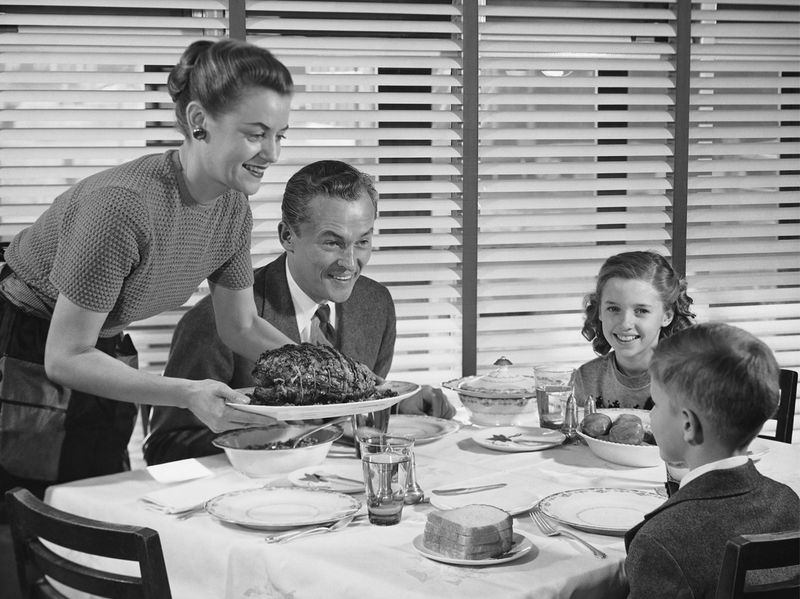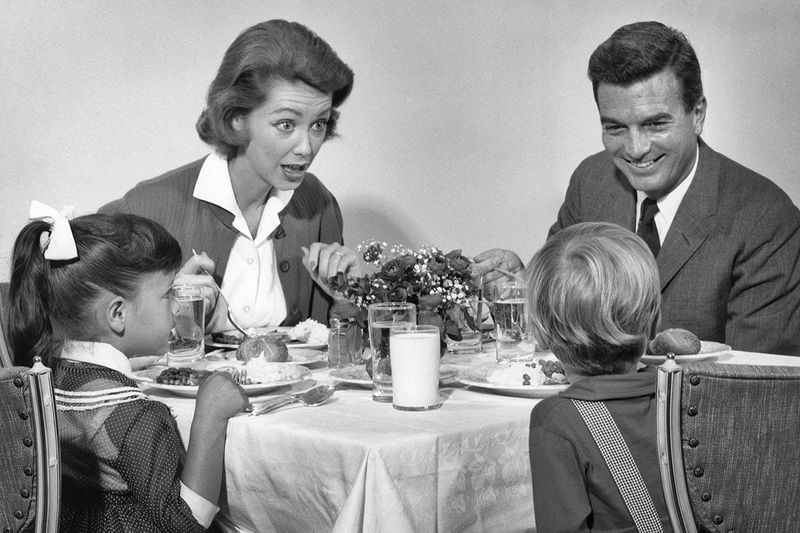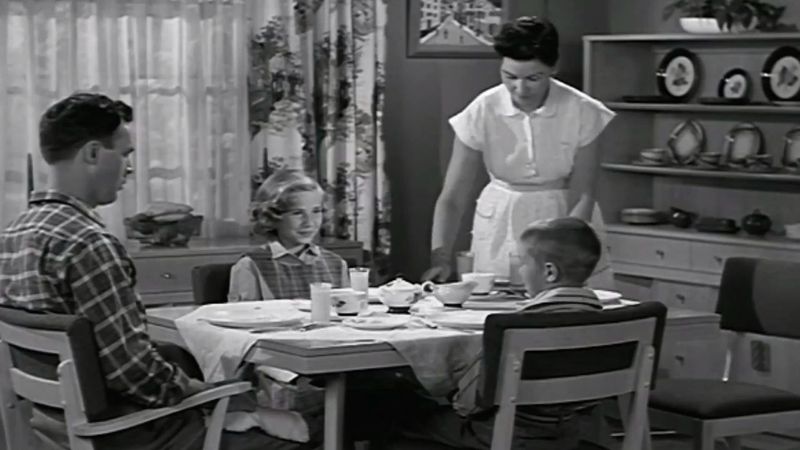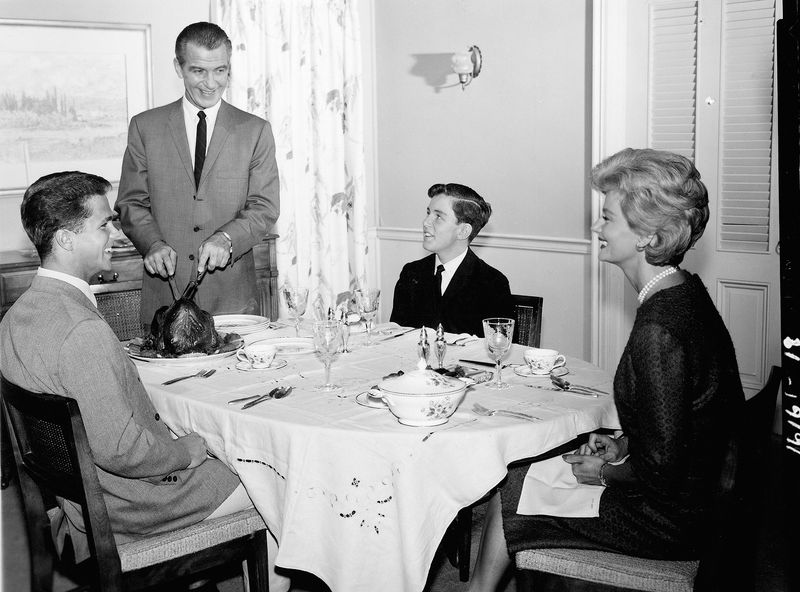The 1960s were a time of transformation, yet dinner table etiquette remained steeped in tradition. Rules that seem peculiar today were the norm then, reflecting societal values and expectations.
This list explores 17 such rules, offering a glimpse into the past and how much our dining habits have evolved.
1. No Elbows on the Table
In the 1960s, keeping your elbows off the table was more than etiquette; it was an unwritten rule.
Not only was it seen as a sign of respect, but it also encouraged better posture. Parents believed that teaching children to sit upright would instill discipline.
Children were constantly reminded, sometimes with a gentle nudge or a stern glance, to keep their elbows off the table.
This rule was so ingrained that many kids would remind each other, creating a peer-enforced system of etiquette. Today, while manners are still important, such stringent rules have relaxed, much to the relief of casual diners.
2. Stand When an Elder Enters
In the 1960s, respect for elders was paramount, especially during meal times.
If an elder entered the dining room, everyone was expected to stand until the person was seated.
This practice was seen as a sign of respect and acknowledgment of their presence.
It was a way to teach children the importance of honoring their elders and instilling respect as a societal norm.
Today, while respect remains important, such formalities have largely faded, with many preferring a more relaxed dining atmosphere.
The change reflects broader societal shifts towards casualness in family interactions.
3. Wait to Be Seated
During the 1960s, waiting to be seated was a common practice that underscored the formality of family dinners.
The head of the household or the host would determine when everyone could sit down.
This rule emphasized respect for authority and the structure within the family unit.
Such etiquette taught children patience and reverence for the family hierarchy.
Today, this rule is often seen as outdated, with most families opting for a more casual approach to dining.
The shift to less formal dinners mirrors changes in family dynamics and societal structures.
4. Eat What’s Served
The rule of eating whatever was served was deeply ingrained in 1960s households.
Children were expected to finish their meals without complaints, fostering gratitude for the food provided.
This practice was also a way to avoid wastage, a value that was highly emphasized post-war.
Parents believed this rule would teach children to appreciate what they had and develop a willingness to try new things.
Nowadays, with a focus on dietary preferences and food allergies, this strict rule has become more flexible, catering to individual needs and choices.
5. Speak Only When Spoken To
At the 1960s dinner table, children were often expected to speak only when spoken to.
This rule fostered an environment of respect and attentiveness, as children learned to listen rather than dominate conversations.
It was believed that this would help them develop into respectful and considerate adults.
Families valued a quieter dining experience, where the focus was on the meal and adult conversation.
In contrast, today’s family meals are often more inclusive, encouraging children to express their opinions and engage freely, reflecting a shift towards valuing children’s voices.
6. No Leaving the Table Until Everyone Finishes
In the 1960s, leaving the table before everyone was done was considered impolite.
This rule emphasized the importance of family togetherness and patience.
Children learned to understand and respect the value of shared family time over meals.
Parents believed that waiting for everyone to finish fostered a sense of unity and respect within the family.
Nowadays, meals can be more hurried, reflecting busier lifestyles and more flexible dining practices, allowing family members to leave as they please.
This change mirrors evolving family dynamics and the increasing demands on time.
7. Always Use a Napkin
Using a napkin was a staple of 1960s dining etiquette, emphasizing cleanliness and proper manners.
Children were taught to place their napkin on their lap before eating, ensuring they remained tidy throughout the meal.
It was considered disrespectful to ignore this rule, as it showed a lack of consideration for the family’s dining standards.
Parents believed these small acts of etiquette would translate into broader life skills.
While napkin use remains a norm today, the rigidity surrounding its use has softened, with many embracing more relaxed dining environments.
8. Proper Utensil Use
Correct utensil use was a fundamental part of 1960s dining etiquette.
Children were taught to use their knife and fork with precision, reinforcing good manners and dexterity.
Mastering this skill was seen as a reflection of their upbringing and social training.
It was common for parents to correct their children’s utensil use during meals, emphasizing its importance.
Today, while proper utensil use is still valued, the strictness of its enforcement has diminished, allowing for more personal comfort and cultural variation at the dining table.
This reflects a broader acceptance of diverse dining customs.
9. No Electronics at the Table
Though electronic gadgets were scarce in the 1960s, the principle of no distractions at the table was strictly upheld.
Families valued uninterrupted conversation and attention, focusing solely on each other’s company during meals.
This rule emphasized the importance of family bonding and shared experiences.
Today, the prevalence of smartphones and tablets has challenged this tradition, with many families striving to reclaim meal times as gadget-free zones.
This ongoing struggle highlights the enduring value placed on quality family interaction, despite technological advancements.
10. Thank the Cook
Expressing gratitude to the cook was a cherished tradition in 1960s households.
Families emphasized the value of acknowledging the effort that went into preparing meals.
This practice taught children to appreciate the hard work behind their food and recognize the contributions of family members.
Parents believed that instilling gratitude would foster a sense of community and respect within the family.
While thanking the cook remains a common courtesy today, it reflects a broader cultural shift towards appreciation and mindfulness in everyday interactions, reinforcing the timelessness of gratitude.
11. No Talking with Mouth Full
Refraining from talking with your mouth full was a strict rule in the 1960s, emphasizing the importance of manners.
This practice was intended to prevent unsightly displays and promote polite conversation.
Parents instilled this rule to ensure that children learned to eat gracefully and communicate effectively.
While this etiquette rule still holds today, its enforcement is often less rigorous, with many families accepting occasional lapses as part of casual dining.
The continuation of this tradition underscores the enduring desire for civility and respect at the table.
12. Pass Dishes to the Right
Passing dishes to the right was a common practice in the 1960s, designed to maintain order during meals.
This rule ensured a smooth flow of food and minimized confusion at the table.
Parents taught children this system to foster cooperation and attentiveness.
It was an unspoken guide that kept meals orderly and efficient, reinforcing the value of shared family duties.
Today, while some families maintain this tradition, many have adopted more relaxed methods, reflecting a shift towards personal convenience over strict table manners, mirroring broader changes in social structures.
13. No Slouching
Maintaining good posture was a vital component of 1960s dining etiquette.
Parents insisted that children sit up straight to reflect discipline and attentiveness.
This rule not only promoted physical health but also conveyed respect for the meal and company.
It was believed that good posture would positively influence other aspects of behavior.
While the importance of posture is still recognized today, the strict enforcement has relaxed, allowing for a more comfortable dining environment.
This change reflects a broader cultural shift towards prioritizing comfort and practicality in daily life.
14. Dress Appropriately for Dinner
Dressing appropriately for dinner was a sign of respect and formality in the 1960s.
Families often dressed in their best attire, even for meals at home, to honor the occasion.
This practice encouraged children to associate dining with dignity and social decorum.
Parents believed that presenting oneself well was an essential life skill.
Today, while dressing for dinner can still be valued, the trend towards casual attire reflects a shift towards individual expression and comfort, mirroring changes in societal norms and lifestyles.
15. Family Prayer or Grace
Saying grace before meals was a common tradition in 1960s households, emphasizing gratitude and family unity.
This practice provided a moment of reflection and appreciation for the food and the company.
Parents used this time to teach children the importance of thankfulness and community.
While family prayers at meals still exist today, their practice varies widely, reflecting diverse beliefs and lifestyles.
This tradition’s evolution highlights changes in religious practices and the growing emphasis on personal values and inclusivity in family rituals.
16. Be On Time for Dinner
Punctuality was a crucial aspect of 1960s dining etiquette.
Being on time for dinner showed respect for the family and the effort put into preparing the meal.
It underscored the importance of family cohesion and shared experiences. Parents taught children that tardiness was disrespectful and disrupted family harmony.
In today’s busy world, while punctuality is still appreciated, dining schedules have become more flexible, accommodating the complexities of modern life.
This shift reflects broader changes in family dynamics and the balancing act of contemporary responsibilities.
17. Silence During Soup
Imagine a world where the simple act of eating soup required absolute silence. For some families in the 1960s, this was a reality. The sound of slurping, clinking, or even a gentle sigh was considered disruptive.
Silence was a sign of respect for the meal and those who prepared it. Conversations, laughter, or interruptions were strictly off-limits until the last drop of soup was consumed.
This practice, though puzzling now, was seen as a way to instill mindfulness and appreciation. It encouraged diners to savor every slurp in peace, reflecting on the day’s events in contemplative silence.


